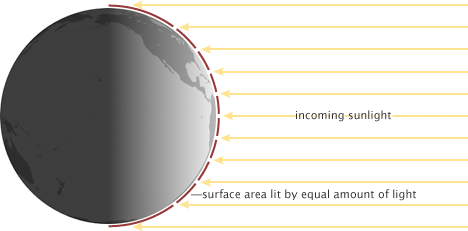Atmosphere Contents
3. Energy Variation
The amount of solar radiation received by the Earth varies with distance from the equator

If the Earth had a vertical axis of rotation, then incoming solar radiation would be unevenly distributed across the Earth's surface. The intensity of the radiation (energy) would be greatest at the Equator and weakest at the poles. There are two reasons for this; first, the inverse-square law (Intensity a 1/distance2) means that solar radiation at the poles has further distance to travel, so it is spread out over a larger area, and the intensity is reduced and second, the radiation passes through a thinner layer of the atmosphere at the Equator than at the poles, so less radiation is absorbed for reflected before it reaches the surface.
Why does the amount of solar radiation received by the Earth varies with distance from the equator?